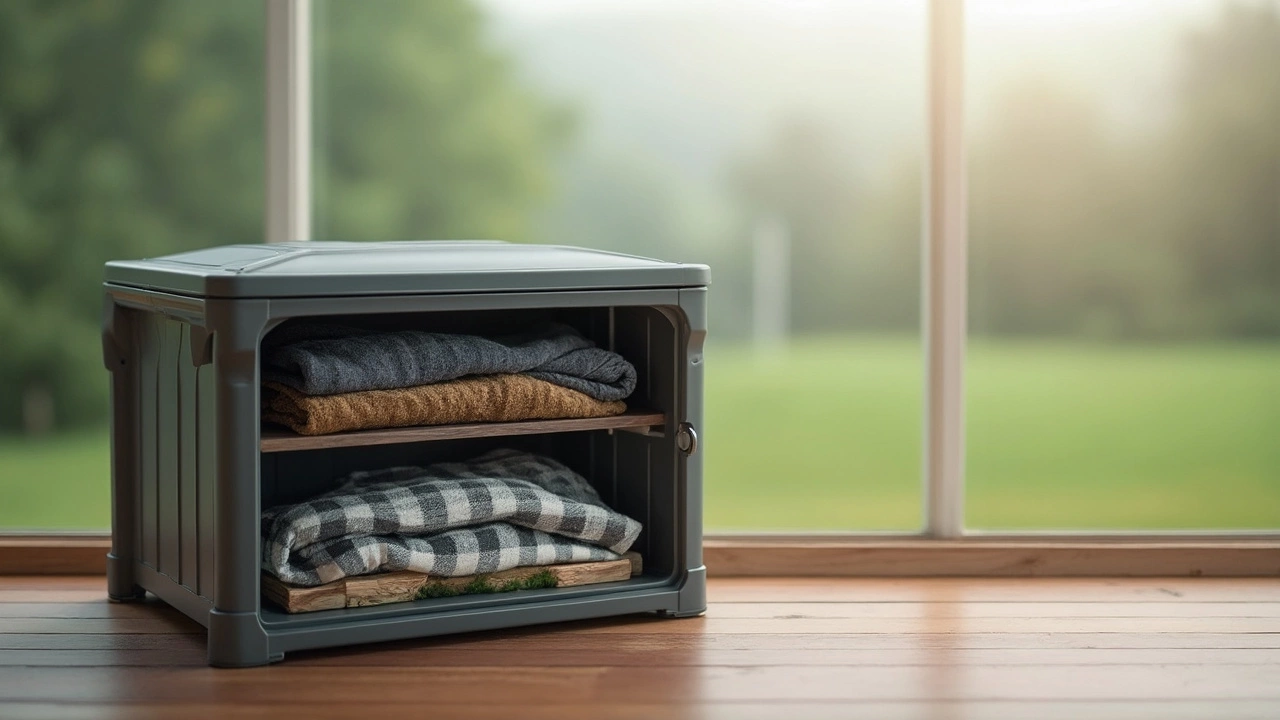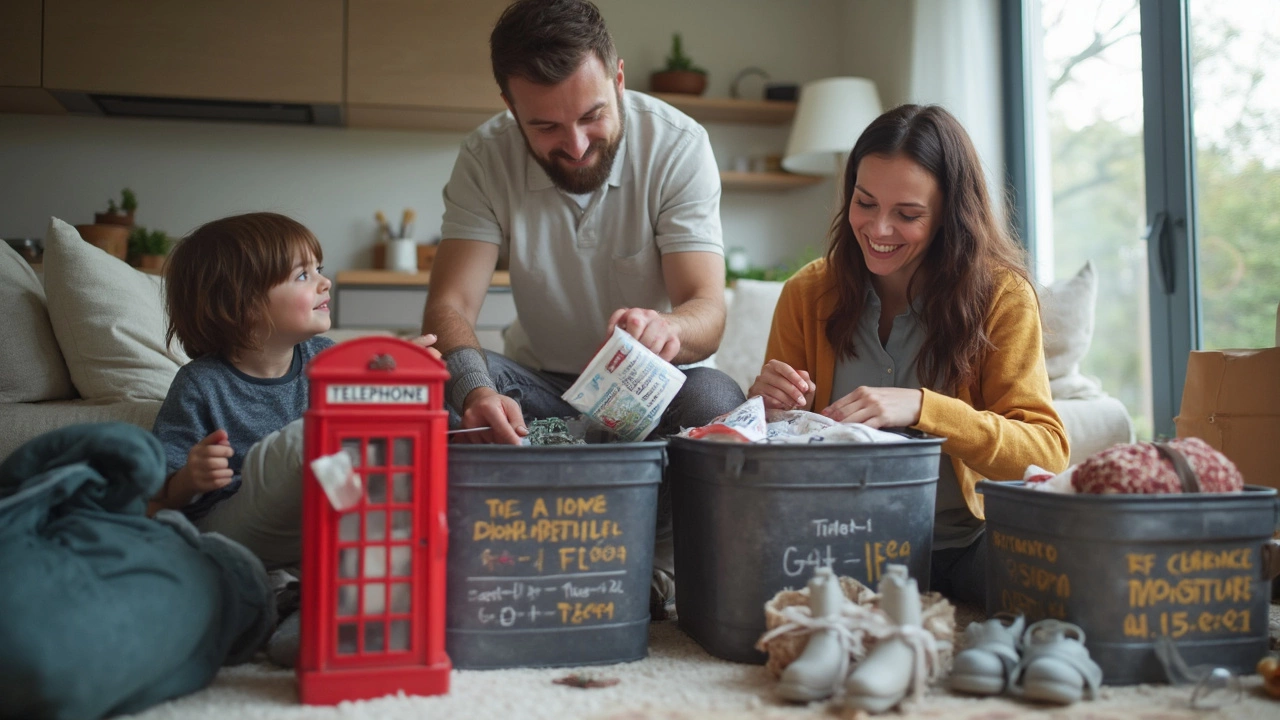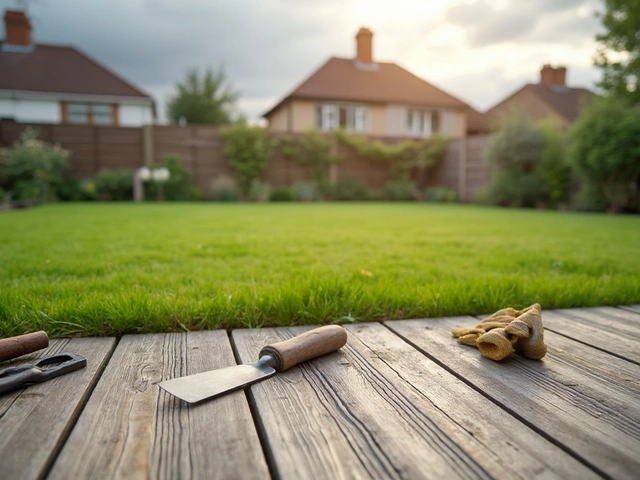 3
Jun,2025
3
Jun,2025
Ever pull out your favorite jacket only to find ugly mold spots? Mold sneaks into storage bins way faster than you expect. The real culprit is trapped moisture—sometimes just a little humidity is enough to turn your bins into a mold factory.
To block mold, you need stuff that fights moisture from the moment you close the lid. Skip the guesswork: toss in silica gel packets, activated charcoal pouches, or even simple baking soda. Each of these grabs extra moisture from the air, making it way harder for mold to grow.
If you've got stuff like books, clothes, or electronics tucked away, don't just hope for the best. Add these moisture-fighters before you store them. You can even make a DIY mix at home—just fill a sock with baking soda or kitty litter and tie it off. Instant moisture trap, done.
- Why Mold Appears in Storage Bins
- Top Products and DIY Fixes to Stop Mold
- Choosing the Right Bins for Mold-Free Storage
- Smart Packing Tricks to Keep Items Dry
- Long-Term Checks and Quick Fixes
Why Mold Appears in Storage Bins
Mold isn’t just random. It pops up when three things come together: moisture, something organic (like your clothes or cardboard boxes), and not much airflow. Toss any damp items in a bin, or leave them in a humid garage, and mold spores get cozy fast. These spores are everywhere—some studies say mold spores hang around in nearly every home.
Why do bins make it even easier for mold? Here’s what’s really happening inside:
- Humidity Trapped: Plastic bins or totes keep out water, but they also trap any moisture inside. In sealed bins, whatever you start with is what you’re stuck with—moisture included.
- No Air Circulation: Mold loves stale air. Without ventilation, even a small amount of water vapor gets stuck.
- Organic Material: Things like clothes, books, and certain plastics actually feed some mold types. It’s like an all-you-can-eat buffet for spores.
- Dirty Items: Dirt and grime can carry even more spores into the mix.
Check out the numbers below—these give you real insight into just how quick mold can move in when conditions are right:
| Condition | Mold Growth Time |
|---|---|
| Humidity above 60% | 24-48 hours |
| Clothing stored slightly damp | 1-2 days |
| Unwashed items | Under 3 days |
Dr. Emily Walsh, a trusted indoor air quality expert, sums it up perfectly:
"Mold only needs a little moisture and a forgotten corner to thrive. Once it starts, it can ruin fabric, break down paper, and even affect your health."
So, don’t blame your storage bins; blame anything moist or organic inside—and make sure that’s tackled before you lock things away.
Top Products and DIY Fixes to Stop Mold
If you want to keep your things mold-free, you need to go beyond just closing the lid tight. Certain products are way more reliable than others when it comes to fighting damp air inside storage bins. Here’s what actually works, and why:
- Silica Gel Packets: Those little packs you see in shoeboxes and backpack pockets? They’re for real. One ounce of silica gel can absorb about 40% of its weight in water vapor. Throw in a few packets for every 10-gallon bin. You can even buy bigger packets specifically for storage containers, and they last for months.
- Activated Charcoal Bags: These don’t just help with moisture—they zap odors too. Get a few small bags from any store, or make your own by filling old socks or pouches with charcoal. Replace them every 2-3 months for best results.
- Baking Soda: This one’s cheap and easy. Use an open box or pour it into a cloth bag. It won’t work as fast as silica gel, but it’ll suck up some humidity and keep musty smells away. Change out the baking soda every two months.
- Calcium Chloride Moisture Absorbers: Products like DampRid use this mineral to pull serious moisture out of the air—trust it for basements or long-term storage. Just be careful where you put the canister so it doesn’t spill.
- DIY Kitty Litter Packs: New clay-based litter works like a big sponge. Pour some in a sock, tie it off, and chuck it in the bin. It’s cheap, easy, and surprisingly effective.
Not sure how they compare? Here’s a quick look at how much water each can absorb in a small bin over a month:
| Moisture Absorber | Water Absorbed (per 30 days, per 100g/3.5oz) | Odor Control | Lasts For |
|---|---|---|---|
| Silica Gel | ~40g | Good | 2-6 months |
| Activated Charcoal | ~30g | Excellent | 2-3 months |
| Baking Soda | ~20g | Medium | 1-2 months |
| Calcium Chloride | ~60g | Fair | 2-3 months |
| Kitty Litter | ~35g | Medium | 1-2 months |
For the cleanest results, don’t leave your bins stuffed full—air needs to circulate a bit. And always check for any leaks or cracked lids. Just a tiny bit of dampness can undo all your hard work.

Choosing the Right Bins for Mold-Free Storage
Not all storage bins are made the same—some are way better at keeping mold out. The big thing to look for is airtight lids. If air can sneak in, so can moisture, and that's prime real estate for mold. Plastic bins with rubber gaskets make a solid seal, cutting off the humidity that mold loves. Regular snap-on lids don’t cut it if you live somewhere humid or want long-term storage.
Another must? Go for bins that are see-through. Clear bins let you check on your stuff without opening them up. Less time open means less air—and fewer problems. Plus, you can spot warning signs like condensation before it’s too late.
Stay away from cardboard boxes for anything you care about. Cardboard soaks up moisture like a sponge and gives mold exactly what it wants. If you already use cardboard, at least double up with a plastic bag inside. But for the best results, stick with *plastic storage bins* designed for the job.
- Storage bins with gasket lids keep out most moisture
- Clear bins let you keep an eye on your stuff without letting air in
- Thicker, durable bins resist cracks where moisture creeps in
- Avoid bins made from fabric or cardboard for long-term storage
A quick look at which bins work the best for fighting mold:
| Bin Type | Mold Resistance | Best For |
|---|---|---|
| Plastic (airtight/gasket) | Excellent | Clothes, books, electronics |
| Plastic (snap-on lid) | Good | Toys, linens |
| Cardboard box | Poor | Short-term, dry spaces only |
| Fabric bin | Poor | Stuff that needs to breathe, but dry areas only |
Don’t forget to dry out bins before loading them up. Even the best sealed bins do nothing if you trap moisture inside from the start. A quick wipe and a few hours of air-drying can save a ton of headaches later.
Smart Packing Tricks to Keep Items Dry
Mold doesn’t just show up by accident in storage bins. A lot of it starts with poor packing. Here’s how to level up your packing game to keep everything inside your bins safe and dry.
First off, always use clean and totally dry items. If you pack up clothes or books with even a tiny bit of dampness, you’re basically asking for mold. It takes just 24–48 hours for mold to start growing when things stay moist. If you’re not sure whether something’s dry, leave it out overnight to air out before tossing it into storage.
Next, avoid cramming stuff so tight that air can’t move. When air is trapped and can’t circulate, any trapped humidity sticks around. Try rolling clothes instead of stacking or folding them, and keep items in smaller groups. That way, air moves just enough to lower the chance of moisture build-up.
- Wrap delicate things like photos, documents, and fabrics in acid-free paper or cotton pillowcases. Plastic bags can trap condensation if the temperature shifts.
- Layer moisture-absorbing materials inside bins. Put a thin towel or a sheet of unprinted newspaper at the bottom of each bin to suck up any stray vapor.
- If you’re storing shoes, tuck a couple of silica gel packs inside each pair. Old shoes are notorious for turning into mold magnets.
Got a storage bin in the basement or garage? Raise it off the ground. Stick it on a shelf or use a wooden pallet—this stops cool ground moisture from creeping in through the bottom of your bin.
| Item Packed | Ideal Moisture-Grabber |
|---|---|
| Clothes & Linens | Silica gel or baking soda pouches |
| Electronics | Silica gel or activated charcoal packs |
| Books & Photos | Unprinted newspaper, acid-free tissue |
| Shoes | Silica gel inside each shoe |
Here’s one more tip: label bins clearly with dates. That way, if you ever find moisture inside, you’ll know exactly how long things have been packed up and when you should swap out those moisture absorbers.
If you care about storage bins staying mold-free, these smart packing tricks give your stuff the best odds. Taking a few extra minutes can save you a ton of clean-up headaches down the road.

Long-Term Checks and Quick Fixes
Here’s the thing about fighting mold—it's not a set-it-and-forget-it deal. Even if you packed those storage bins perfectly, stuff can still go wrong over time. Moisture finds a way in, and the temperature in your basement, attic, or closet can change fast. Checking on your bins just a couple of times a year can save you from nasty surprises.
Set an alarm in your phone for every six months, then do a 10-minute review. Pop those lids open. Give everything a quick sniff for that musty mold smell—trust your nose, it’s your best tool. Look for any dark spots or fuzz in corners. It sounds simple, but catching even a little mold early makes cleaning way easier.
- Replace any silica gel or moisture absorbers every 6-12 months. They work hard but don’t last forever.
- See visible mold? Remove the item right away, clean the bin with vinegar or rubbing alcohol, then let it dry completely before restocking.
- If the area around your bins feels damp or smells off, add a small dehumidifier nearby. These can cut air moisture by up to 50%.
- Rotate the position of your bins if possible, or air them out on a dry, sunny day once a year.
If you spot water droplets inside a bin, that’s condensation—another red flag. Wipe those dry and add fresh absorbers. And if you find a soggy or broken lid, just swap it out. Don’t risk all your stuff for a busted cover.
Here’s a quick snapshot of how often to check and replace things:
| Item/Action | Check/Replace Frequency |
|---|---|
| Silica Gel Packets | Every 6-12 months |
| Activated Charcoal | Every 3-6 months |
| Bin Lids/Seals | Every 12 months (or if damaged/leaking) |
| Visual/Smell Check | Every 6 months |
| General Airing Out | 1-2 times a year |
Staying ahead with these checks means your stuff stays dry and mold-free, and your bins last way longer. It’s a quick routine that pays off—nobody wants to toss out their favorite things because of a little mold that could’ve been stopped.




